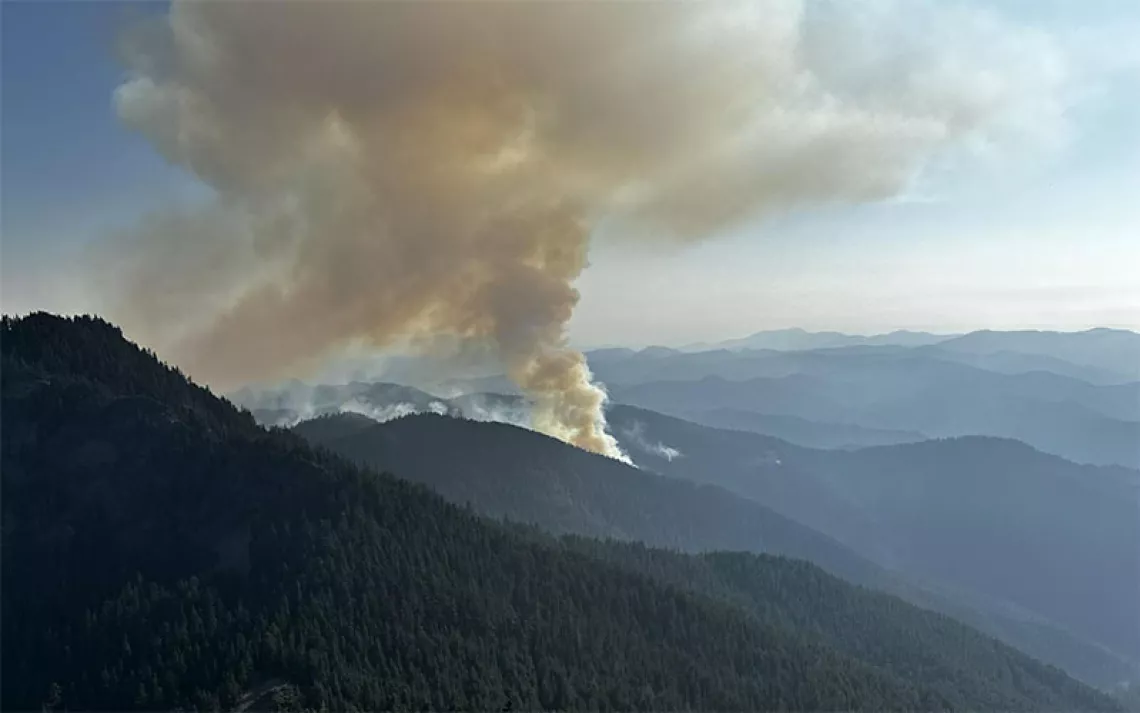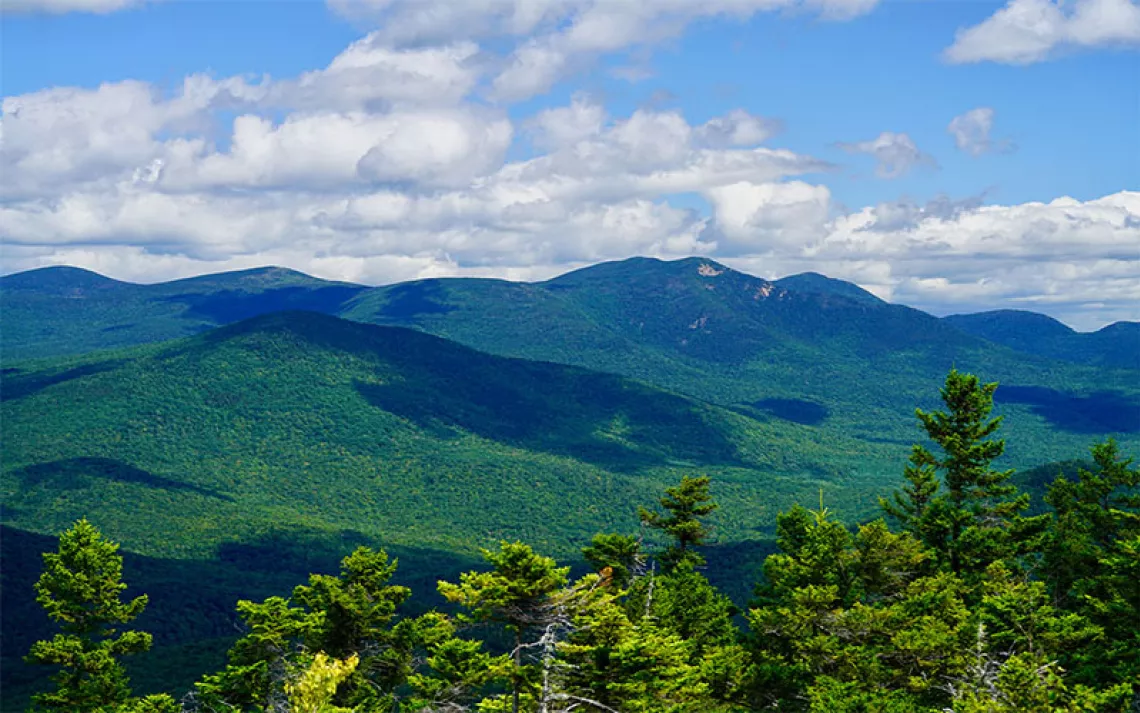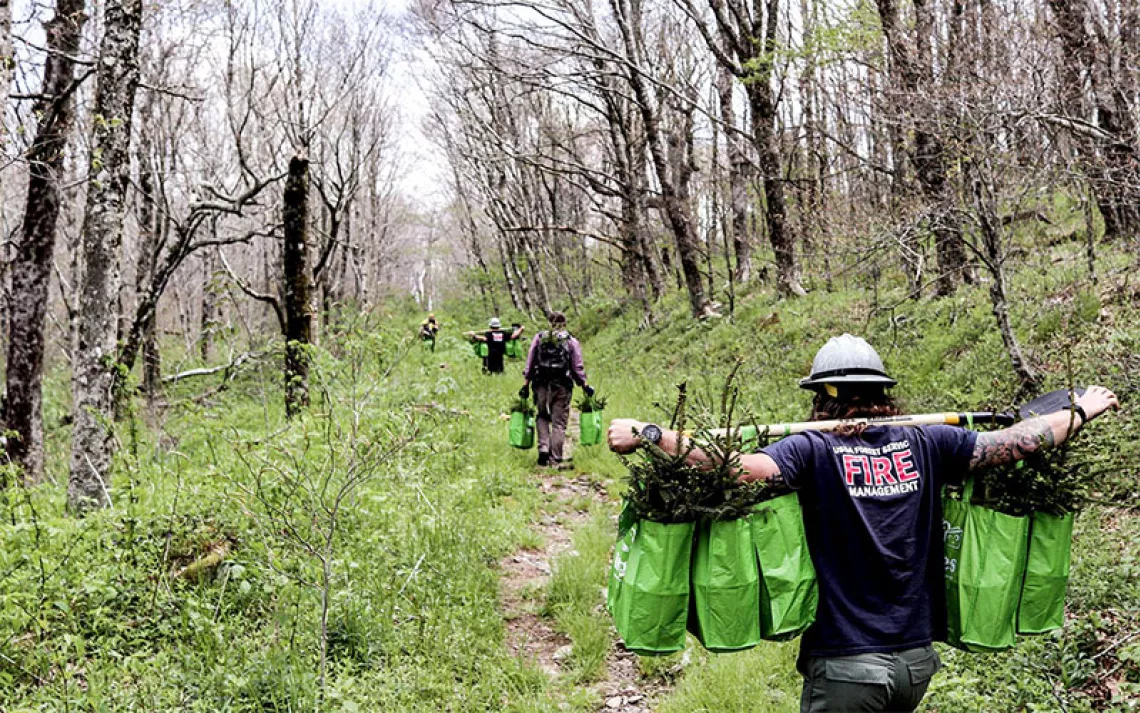Here in the WUI

Photos courtesy of Barnhart Photography
One Sunday morning late last summer, as wildfires burned in every direction from our small mountain valley, we gathered at the swim dock. Thick smoke hovered. Ash fell like snow.
A dozen or so neighbors, ages eight to 60-plus, stood in wetsuits or in knee socks waiting for the start of our first-ever triathlon. One runner wore a multicolored yarn wig. Several bikes sported ribbons and streamers. Some participants would complete the entire course: half-mile lake swim, eight-mile bike, two-mile run. Others had formed makeshift teams. An unofficial official in a yellow hardhat and orange vest announced the only rule: There would be no rules.
When I moved to this valley 25 years ago, you could count on one hand the number of wildfires that had grown larger than 1,000 acres in the past 100 years. Since then we’ve watched more than 100,000 acres burn in a 20-mile radius from home. Of course we take the threat seriously. We started a volunteer fire district. We hold work parties to create so-called defensible space. We’ve attended workshops on Firewise principles. We’ve cleared dead vegetation, moved firewood piles, screened soffits, and cleared under decks. We’ve pruned ladder fuels—low-hanging dead limbs that can carry flames upward—from conifers and raked duff away from outbuildings. We drafted a community wildfire protection plan to integrate our efforts with state and federal land managers.
But at some point life goes on. So, when a local teenager proposed a triathlon, we thought, why not?
The unofficial official blew a whistle, and we splashed into the water swimming, stroking hard toward a yellow kayak marking the turnaround in which two more unofficial officials waved a big red flag. Breathe right and watch trees torch on the ridge top. Breathe left and pass a cabin. Watch for the big red flag somewhere out in the smoke that seemed to stretch from Oregon to Canada, east to Montana or beyond. We arose dripping from the water while dogs nipped at our heels. Then bikers headed off past fire-scarred forest—black, silver, bronze, and rust—with fire names that echo in our collective memory: Wolverine, Flick Creek, Rainbow Bridge, Tolo.
The Boulder Fire, in 1994, was the first to come close. We sat on tailgates to watch the fiery fringe snake down a steep drainage three miles away. Sparks spewed into the night air as trees torched and flames leapt crown to crown from valley bottom to ridge top, then trickled back down, over and over. By day, we packed for evacuation fretfully and debated fire management until finally a late-season rainstorm put our fears to rest. Nowadays, like so many things in middle age, our response to fire is less emotional—less frantic, less awed—and more nuanced and pragmatic. It's whittled down to the nitty gritty: trying to keep things running—the fire pump, the generator, the sprinklers on the roof—and remaining vigilant.
Fire, which used to be an occasional unruly visitor, has carved out a permanent place here in the Wildland Urban Interface. (Defined as areas where houses meet wild vegetation in the mountains or in the woods or in the sagebrush hills, the WUI—pronounced “woo-eee”—sounds a lot more fun than it is.) Back in 1988, when the National Park Service allowed a handful of wildfires in Yellowstone to burn into a 1.2 million acre conflagration, the battle lines around fire became hard-drawn. Scientists explained that too much fire-suppression had made the forest unnatural in places where, for example, fire-dependent Ponderosa pine gave way to shade-tolerant Douglas fir. Meanwhile, those who lived in nearby communities saw their homes and livelihoods threatened. Thirty years later, here in the WUI, those debates seem distant, nearly quaint. The all-or-nothing rhetoric has given way to reality: We can let some fires burn, yes, but not in August, not so close to town.
Commentators argue that the WUI is dangerous and costly, that those who live here need to take more responsibility for what it costs to fight the fires. Some say houses in the WUI should no longer be insured or built. Yes, all of that makes sense, but meanwhile we’re still here. This is our home. For years those voices, reverberating in the echo chamber of op-eds and later on social media, cemented in me and my fellow WUI-ites a stubborn contrariness. Even as we planned for the worst, I believed, like most of my neighbors—the men, at least—that I’d stay through evacuation, any evacuation. We knew people personally who’d saved houses, their own and their neighbors’, by spraying garden hoses in flip flops while firefighters backed out or focused attention elsewhere. With that in mind, who would not plan to stay?
Not me. Not anymore. It’s scarier than it used to be. We watch the NOAA weather forecast and see the temperature rising astronomically, impossibly—isn’t this the Pacific Northwest?—and the humidity dropping. Fuel temperature is listed, too, right there on the website, but some days, often, I cannot bear to look at that column. We’re set to leave at a moment’s notice with a generator running, the passports in a manila folder, and the cat in a box.
We wait for the sound of distant thunder, dreaded but not unexpected. All it takes is one close strike.

*

Days before the triathlon, the Wolverine fire burned over Domke Lake, where a lone longtime inhabitant lived in sparse isolation renting rustic cabins and canoes to weekend fisherman. When the fire came, he had no time to hike out. He rowed out into the center of the lake as he had always planned to do in such an emergency. The air singed his lungs. The word “ember” no long applied to the flaming logs spinning from the sky. He dropped from the boat and submerged in the water, according to lore, and came up as necessary to take sips of throat-scalding air. And so he spent the night.
From the swim dock, as we awaited the bikes to return for the final handoff, we could see the ridges around Domke blackened and bare. The fire had burned so hot the earth was scalded, sterilized. By spring, it would look like the Sahara. The runners hit the pavement: shirtless teenage boys wincing with side aches, small kids sprinting with limbs akimbo, middle-aged joggers weary and grinning. Just one leg left to go.
The plan at first had been to run on a trail, but that would’ve left spectators out of the lurch. So we decided to run the road. If we had run a trail, we’d have passed blackened trunks surrounded by fireweed blooming pink, red ripe thimbleberries, the first plants in succession, so different from the forests they used to be. When I arrived in this valley, no trails were burned. Now few aren’t. Stories from the WUI most often focus on houses destroyed, communities displaced or rebuilt, but the landscape, too, has changed dramatically, astonishingly, and it’s still changing.
Some of those fires were, of course, set on purpose, “prescribed” as they say. Firefighters line the road in fall or spring with drip torches, steel canisters of diesel/gas mix to pour into the duff to set a low intensity burn in hope of restoring forest health in a valley grown over-thick after 100 years of suppression. This is the now-familiar story in the American West. This, too: Try as we might, we in the WUI can’t manage fire alone. We depend on the government for prescribed fire as much as for major suppression. So the tension remains. Who is responsible?
Not long after we started seeing large fires, I traveled to other mountain towns on vacation and was shocked to see A-frame cabins with cedar shake roofs and conifer limbs resting on eaves and gas cans stored in woodsheds. Was it nonchalance? Ignorance? Neglect? No telling. I could see then, clearly, the answer to those red-hot questions. Should the work of prevention be done by homeowners or contractors or federal, state, or local governments or volunteer groups? Yes, yes, yes, yes, yes, and yes.
Meanwhile, in the echo chamber, new ideas circulate. Maybe communities in the WUI should be seen instead, simply, as fire-dependent ecosystems. Native people have known as much for centuries. The Bureau of Indian Affairs in the Pacific Region has moved beyond Firewise to advocate for a new understanding of fire they call 4Rights (Right Time: recognize that fire has different effects depending on the season and the weather. Right Place: integrate the needs of healthy forests, grasslands, streams, plants, animals, and people. Right People: involve multiple generations, youth as well as elders. Right Choice: make a conscious decision about when and where fires should burn). I have to admit I like the concept. Once, when doing research for a book set in the Sierra Nevada, I heard a moving story of young Maidu firefighters starting a prescribed burn with pine boughs, rather than drip torches, after receiving a blessing from elders. This seemed a way to accept fire, to integrate it into culture, and on some level to dodge all the blamey WUI talk. But no matter how much we embrace fire in theory, it’s not so easy to live with in real life.

*
On Facebook in the days following the triathlon, we received scoldings from near and far. How unhealthful! You should stay indoors when air quality is that bad! True enough. I take an inhaled steroid each morning for asthma that may have been triggered by fighting fires, which I did part-time for several years, or by living too close to them. We live regularly through what doctors now call “smoke waves”: days or weeks of skies black with particulates, expected to get exponentially worse in the decades to come and cause more sickness. The danger is real, but so is the danger of gun violence, flooding, traffic, stress. No place is immune to danger. If we in the WUI stayed indoors all fire season, we would never emerge. Besides, the teenager who organized the event would be leaving soon for school, and really, which is unhealthier: anxiety alone or exercise together?
In the weeks to come, bracken ferns browned to a crisp and clusters of maple seeds dangled like kindling. Leaves turned orange, and sunlight through the windows glowed orange, the gray road dust hovered orange, eerie as gas-lit streets in Dickens’s England. I stayed inside reading and stumbled upon a description of another fire right here in 1889 during which a visitor tried to ride up-valley and burned the legs of his pony so badly that he had to wrap them in ointment and bandages to keep the yellow jackets off. As he returned to the lake, the leather on his boots shrunken from the heat, he gazed out at the smoke “which appeared to cover the face of the whole country.”
There’s an odd comfort in history, a reminder that much of the West is, indeed, a fire-dependent ecosystem. But there’s also danger in believing that nothing has changed, that suppression and climate change have not colluded to create bigger fires, hotter, and yes, more dangerous. Within days of the triathlon, we’d hear the horrific reports from Twisp, 25 miles east: three firefighters killed in a fast-moving fire started by dry birch leaves resting on a power line.
Meanwhile, a teenager ran between two orange cones to claim victory in a race with no reward. Afterward, we ate pizza squares and ginger cookies and drank water served in empty jelly jars so there’d be no paper waste, and posed for photos. We listened to strange silence since, for the first time in weeks, poor visibility kept helicopters on the ground. The omnipresent radio chatter was gone, too, the knob twisted to a click. We headed home to turn on the sprinklers and listen and await the blessed arrival of fall.
 The Magazine of The Sierra Club
The Magazine of The Sierra Club



